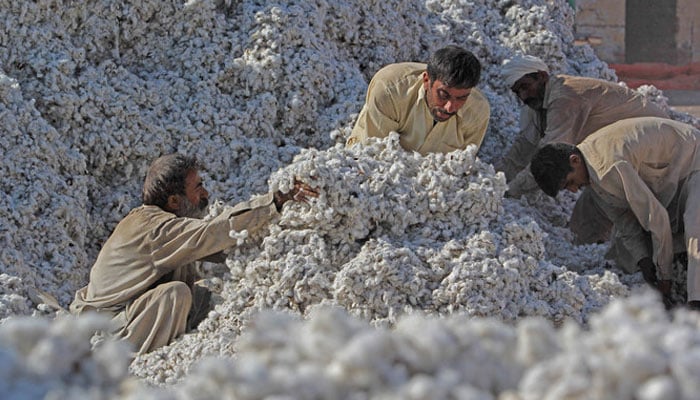Sindh’s cotton arrival surges to 4m bales, Punjab trails behind
LAHORE: As the crop season draws to a close, cotton arrivals have reached only 64 percent of a revised production target for the current year, amid slow arrival from Punjab, according to data from the industry body on Saturday.
The Pakistan Cotton Ginners Association (PCGA) said in its fortnightly report that 7.370 million bales of seed cotton had arrived in ginning factories across the country until Nov. 15, up from 6.794 million bales in the same period last year, when floods damaged the crop.
However, the arrivals were well below the revised target of 11.50 million bales set by the government for the 2023-24 season, which runs from August to December.
Sindh province, which accounts for about 30 percent of the country’s cotton production, led the tally with 3.941 million bales, while Punjab province, which contributes about 70 percent stood second with 3.428 million bales.
As per district-wise breakup, cotton arrival figures of Sindh's Sanghar district surpassed 1.653 million bales, followed by Bahawalnagar district of Punjab with less than half the output, clocking in at 0.818 million bales. Sukkur harvested 0.511 million bales so far, while Rahim Yar Khan managed to get 0.500 million bales. Bahawalpur district bagged fifth position with 0.442 million bales, while Khairpur produced 0.337 million bales.
The PCGA report said the fortnightly flow of cotton saw a declining trend, with 0.576 million bales reaching ginning factories during the Nov. 1 to Nov. 15 period, compared with 0.797 million bales in the previous fortnight.
A total of 455 ginning factories were operational in the country, and there was an unsold stock of 0.768 million bales of cotton available in ginning factories. Of the total cotton arrivals, 0.773 million bales have undergone the ginning process, converting them into marketable cotton bales.
Out of processed cotton or lint, the textile sector purchased 0.632 million bales, and exporters bought 0.279 million bales. Despite repeated assurances from the federal and provincial governments, the Trading Corporation of Pakistan (TCP) did not make any purchases during the cotton season 2023-24, despite cotton prices continuing to decline, leaving growers high and dry.
It is worth mentioning here that Punjab contributes about 70 percent of the country's cotton production, where most of the ginning factories are also located. Despite this, in the current year, cotton production has seen a contrasting trend where Punjab remained in second position as per ginning data.
According to an assessment, owing to an overall low output of silver fiber, cotton imports would be high this year too. In the 2023-24 season, on the back of greater domestic use of fiber, imports are forecast to be around 4.0 million bales. Given available trade data, the 2022-23 import estimate is stated to be 4.5 million bales, despite the crop failure due to record rains and flash floods.
It may be noted that the federal government downward revised the cotton production target to 11.50 million bales from the earlier projected figure of 12 million bales. The high-powered Federal Committee on Agriculture (FCA), which met in early October this year under the chairmanship of Federal Minister for National Food Security and Research Dr Kauser Abdulla Malik, was informed that cotton production for the 2023-24 season was provisionally estimated at 11.5 million bales from an area of 2.4 million hectares. Punjab's cotton output is likely to be around 6.5 million bales during the 2023-24 season against the official target of 8.2 million bales.
It may be mentioned that cotton is an important cash crop for farmers. It accounts for about 6 percent of value addition in agriculture and nearly 1 percent in GDP. It contributes to the national economy by providing raw material to the local textile industry. As cotton buyers, ginners spearhead the first stage of the cotton value chain, converting seed cotton into marketable cotton bales.
-
 Ex-UK Envoy Mandelson Issues ‘unequivocal’ Apology To Epstein's Victims
Ex-UK Envoy Mandelson Issues ‘unequivocal’ Apology To Epstein's Victims -
 Kate Middleton Accused Of Being ‘silent Assassin’ Pitting William Against Andrew
Kate Middleton Accused Of Being ‘silent Assassin’ Pitting William Against Andrew -
 Meghan Markle, Harry 'deliberately' Snubbed Kate Middleton Ahead Of UK Return
Meghan Markle, Harry 'deliberately' Snubbed Kate Middleton Ahead Of UK Return -
 Elon Musk Seeks Sole Custody Of Son After Ashley St. Clair's Trans Support
Elon Musk Seeks Sole Custody Of Son After Ashley St. Clair's Trans Support -
 How To Spot Real Instagram Password Reset Email
How To Spot Real Instagram Password Reset Email -
 Kylie Jenner Makes Subtle Appearance On Timothee Chalamet's Social Handle
Kylie Jenner Makes Subtle Appearance On Timothee Chalamet's Social Handle -
 Jennifer Lawrence Shares Rare Insight Into Relationship With Hubby Cooke Maroney
Jennifer Lawrence Shares Rare Insight Into Relationship With Hubby Cooke Maroney -
 Philippines: Rubbish Landfill Collapse Death Toll Rises To 13
Philippines: Rubbish Landfill Collapse Death Toll Rises To 13 -
 Sanae Takaichi, Lee Jae Myung Meet To Push For Closer Security And Economic Ties At High-stakes Summit
Sanae Takaichi, Lee Jae Myung Meet To Push For Closer Security And Economic Ties At High-stakes Summit -
 Kate Middleton Fears For Family After Shocking Palace Break-in
Kate Middleton Fears For Family After Shocking Palace Break-in -
 Canadian PM Visits China After A Decade Of Diplomatic Strain: What Deals Are In Focus?
Canadian PM Visits China After A Decade Of Diplomatic Strain: What Deals Are In Focus? -
 New York Plans Limited Rollout Of Self-driving Taxis
New York Plans Limited Rollout Of Self-driving Taxis -
 Nvidia Clarifies ‘no Upfront Payment Needed For H200 Chips Production’
Nvidia Clarifies ‘no Upfront Payment Needed For H200 Chips Production’ -
 Sarah Ferguson Faces Painful Choice Between Peace, Family Bond
Sarah Ferguson Faces Painful Choice Between Peace, Family Bond -
 Africa First: Nigeria Set To Approve Landmark AI Rules For Digital Economy
Africa First: Nigeria Set To Approve Landmark AI Rules For Digital Economy -
 WhatsApp Tests Built-in Supervision Feature Long Missing From The App
WhatsApp Tests Built-in Supervision Feature Long Missing From The App




